Pauillac 2018 from barrel
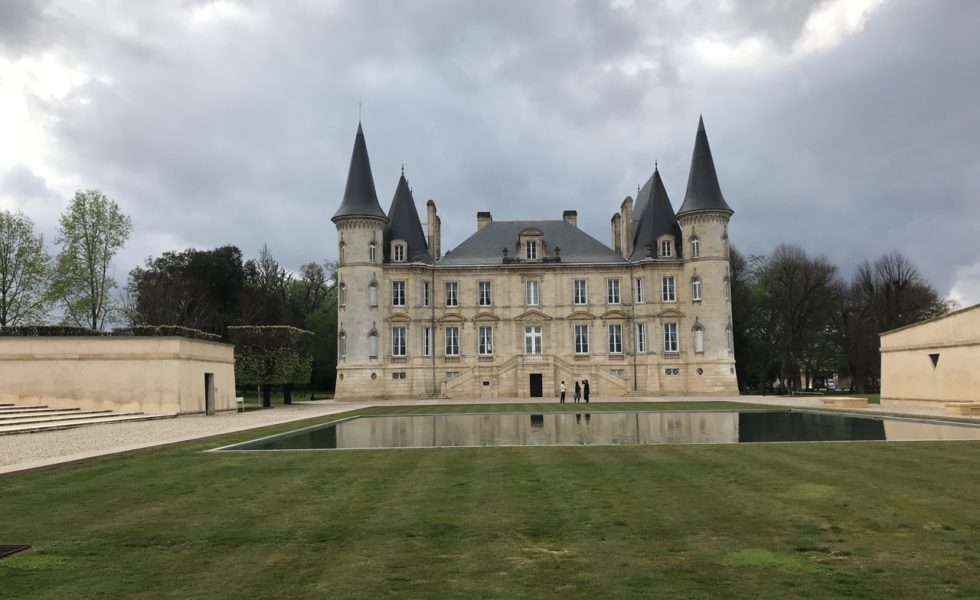
Suave, tannic and sometimes extraordinary
by Panos Kakaviatos for wine-chronicles.com
26 April 2019
Just about as consistent as Saint Julien, Pauillac included many great wines from barrel. I suppose you could say that that is self explanatory, seeing that Pauillac boasts no less than three of five official “first growths” from the ballyhooed 1855 classification. And sure, all three kick 2018 ass.
But as several insiders and friends told me: you get the feeling for some wines of rather powerful tannins that will need time to relax. For some, 2018 may be a modern version of 1986. Considering that Mouton Rothschild for example got “100 points” from Robert Parker, that is not a bad thing at all. I can see why it made the Liv-Ex Top 10 list for the 2018 en primeur survey.
Another style one encounters, on occasion, is a certain headiness, where one can notice a bit of warmth from the high alcohol. Generally speaking, Most Pauillacs are simply great. But words like “best ever” to me at least are all so much hype.
I prefer to taste these from bottle again, before attempting to make such “heady” pronouncements. 😉
As usual, if in bold, I liked in particular. If red and bold, even more. If underlined, too, then potential wine nirvana!
Château d’Armailhac – Clean and ripe fruit on the nose. The palate is smooth and even lacy, although the tannins are somewhat imposing on the finish. Hey! Ever hear of slow oxidation via barrel aging? That’s the purpose of oak aging, not to impose über vanilla notes on fruit from Bordeaux 😉. So, good job! 92-94
Château Batailley – Not as obviously oak driven as in some recent vintages – and that is a good thing. The wine itself has even more imposing tannin that, say, the above wine, and not quite as classy in expression. More Old School, but time in barrel (and five years at least in your cellar), should make for a fine Batailley. 91-93
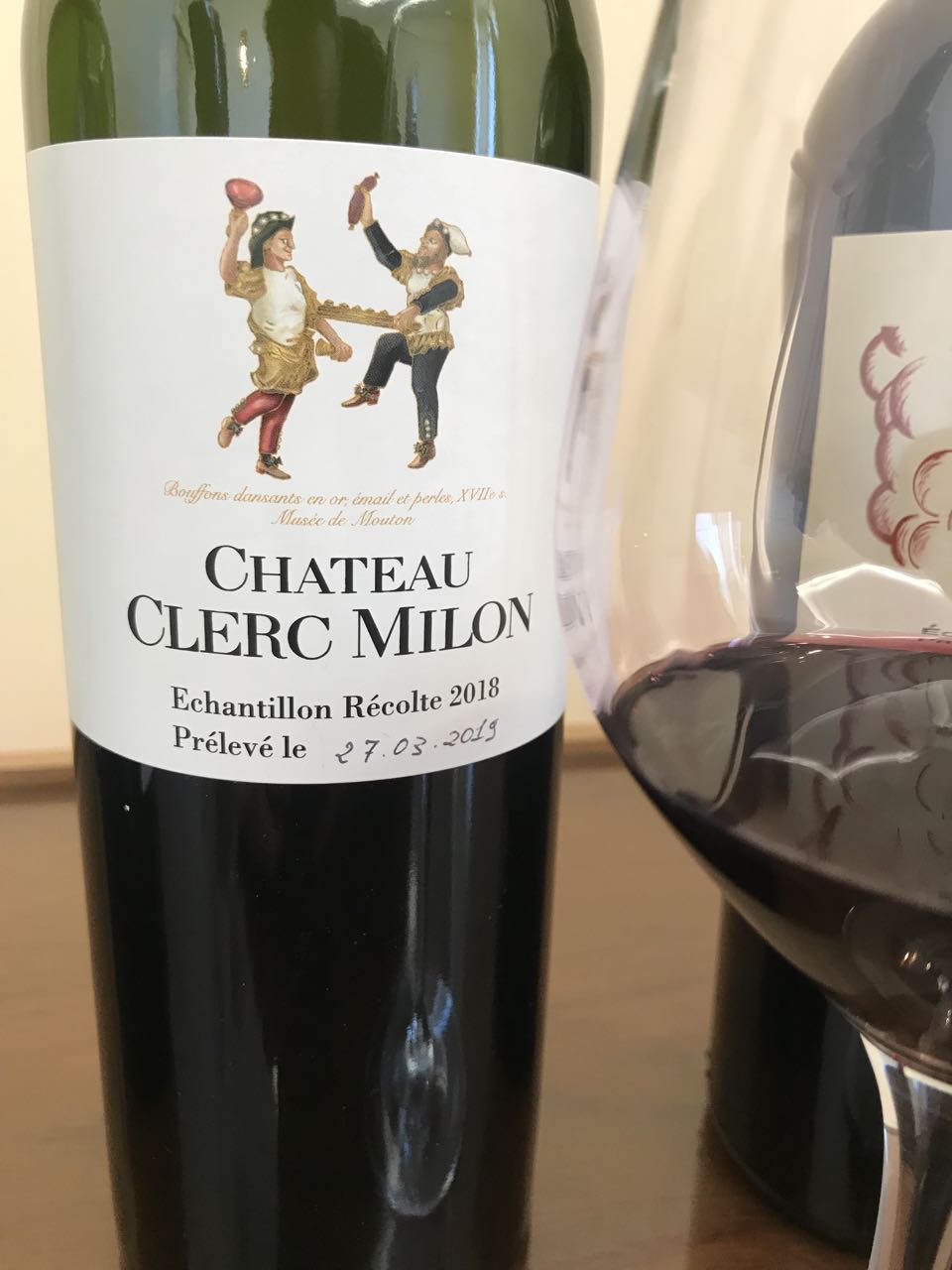
Could be just as good as the 2016.
Château Clerc Milon – The aromatics are cooler than that of the d’Armailhac, and I like that. Tasted at the UGCB and confirmed at Château Mouton Rothschild (under the same direction). Not only blue fruit, but also crushed tobacco freshness. The blend includes 60% Cabernet Sauvignon, more than in the 2010 vintage, and so interesting to note that alcohol in 2018 clocks in at 14.1% as compared to 14.3% in 2010 (“we had more Merlot back then, director Philippe Dhalluin explained). I really like the refinement and focus here, matched by impressive density, wrapped into rather silky tannins. Is it “better” than the superlative 2016? I am not sure. In any case, very nice. 93-95
Château Croizet Bages – This lacks the same finesse and breed of the above, to be sure, as tasted after it at the press tastings of the UGCB. But as far as “fifth growths” go, not bad. Maybe a bit short on the finish for the vintage? Shows pleasing, ripe fruit. 90-92
Château Duhart Milon – Director Eric Kohler says that it is “the best we have ever produced”. I am not sure, as the 2016 seems a bit more refined, but it is hard to dispute him. Why? Château Duhart Milon, a later terroir, was rather suited to the vintage, even if the 3.9 pH is “a bit high” Kohler allowed. Still, at 14.1% alcohol, I do get a touch of warmth on the finish. But enough of the bickering. Why is the wine so good from barrel? The blend of 35% Merlot and 65% Cabernet Sauvignon is rather sumptuous, dense and with refined and elegant tannins. The mid palate? Plenty of juice and sap. And, in spite of the high pH, there is a certain aromatic refreshing aspect to the finish. From the UGCB, I even got a certain delicate, Margaux like approach, no doubt due to the refined tannin. 94-96
Château Grand Puy Ducasse – This is a let down after the elegance and refinement of the preceding wine. Sheesh. Sure, there is ripe fruit, but the wine is coming up short on the finish. Let us wait again to see from bottle. 89-91
Château Grand Puy Lacoste – This is a modern day 1990, so buy it, if the price is not too high. Why? Very smooth and refined, better than the 2009, as the structure is more impressive (I own some 2009s and know). Blending 78% Cabernet Sauvignon and 22% Merlot, it is aging in 75% new oak, which is very nicely integrated. There is also quantity at 40 hectoliters per hectare. Fine freshness on the long finish. What is not to like? Bravo! 94-96
Les Griffons de Pichon Baron – Aging in 60% new oak, this blend of 52% Cabernet Sauvignon and 48% Merlot communicates a certain raw aspect. There is no denying the ripe, dark fruit and density, but I feel that the tannins are on the more ferocious side of this vintage, as tends to be the case with this second wine, but more so in 2018. 90-92
Château Lynch Bages – This has floral and ripe fruit, and such gorgeous perfume on the nose. The palate does show off some austere tannin, and maybe it is a sign of the vintage; I do wonder sometimes if softer vintages like 2015, by comparison, or even 2014, may be more immediately appealing. In any case, the aromatics are so great, that I presume this just needs time to barrel age some of the imposition out, followed by time in your cellar: give it five years and it should be great. More 1989 than 1990? Whereas Gruaud Larose is refined throughout, here we have some imposing tannins on the finish. In that sense, I would purchase Gruaud Larose as a better price/quality ratio. 94-96
Château Lynch Moussas – Rather pleasing aromas, soft. The palate has some hardness that prevents me from scoring too high. I mean, there seems to be a bit of raw tannin in the mix. Sure, it will resolve itself with aging, but it lacks the sheer aromatic interest of the above, which is also a fifth growth, and also a “Lynch”. 90-93
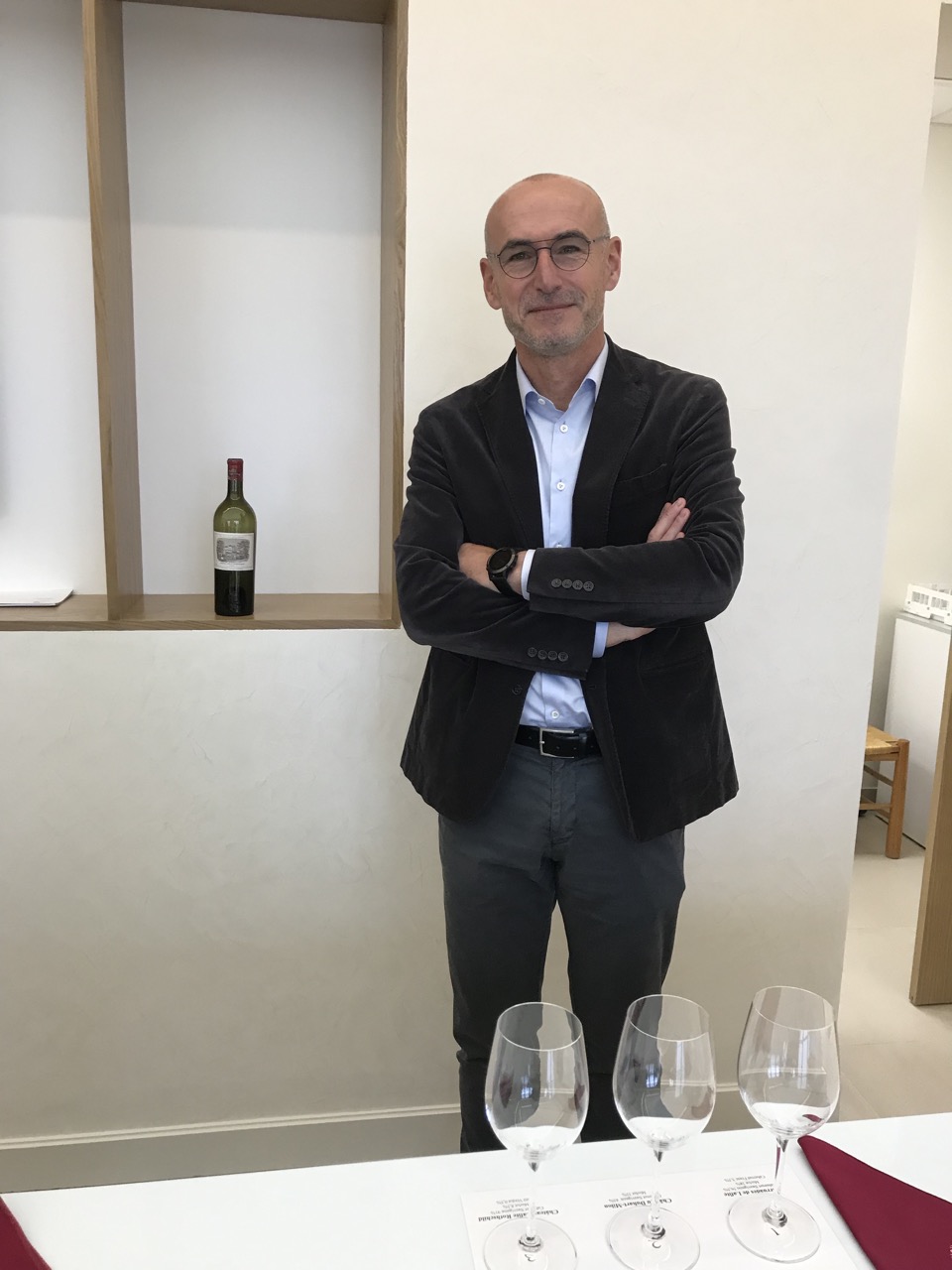
Eric Kohler of Château Lafite Rothschild can smile over possibly the very best wine of 2018.
Château Lafite-Rothschild* – Best wine of Pauillac, and contender for best of the vintage, at least from barrel. At least the Liv-Ex en primeur survey determined already that this is the wine of the vintage. Defies the high 2018 alcohol at “just 13.3%” as it manages pristine balance and opulence. The rather high pH of 3.8 is balanced by lower alcohol, which director Eric Kohler says is largely due to the thick layer of clay within the vineyard that kept things fresh and minimized the effect, at Lafite at least, of some three days of a heat wave where both nights and days were hot. I love the cool graphite nose from this barrel sample, very refined and “confident”. The palate reflects remarkable density combined with freshness. More pencil lead and suave finesse follow through to a finish that lasts almost a minute. The combination of satiny tannins with a Pauillac edge is superb. A great wine in the making, with 91% Cabernet Sauvignon and the rest Merlot and just a touch of Petit Verdot. Comparisons are being made to the 1959, by experienced tasters who actually know the 1959. If you have the cash, go for it. 😊(98-100)
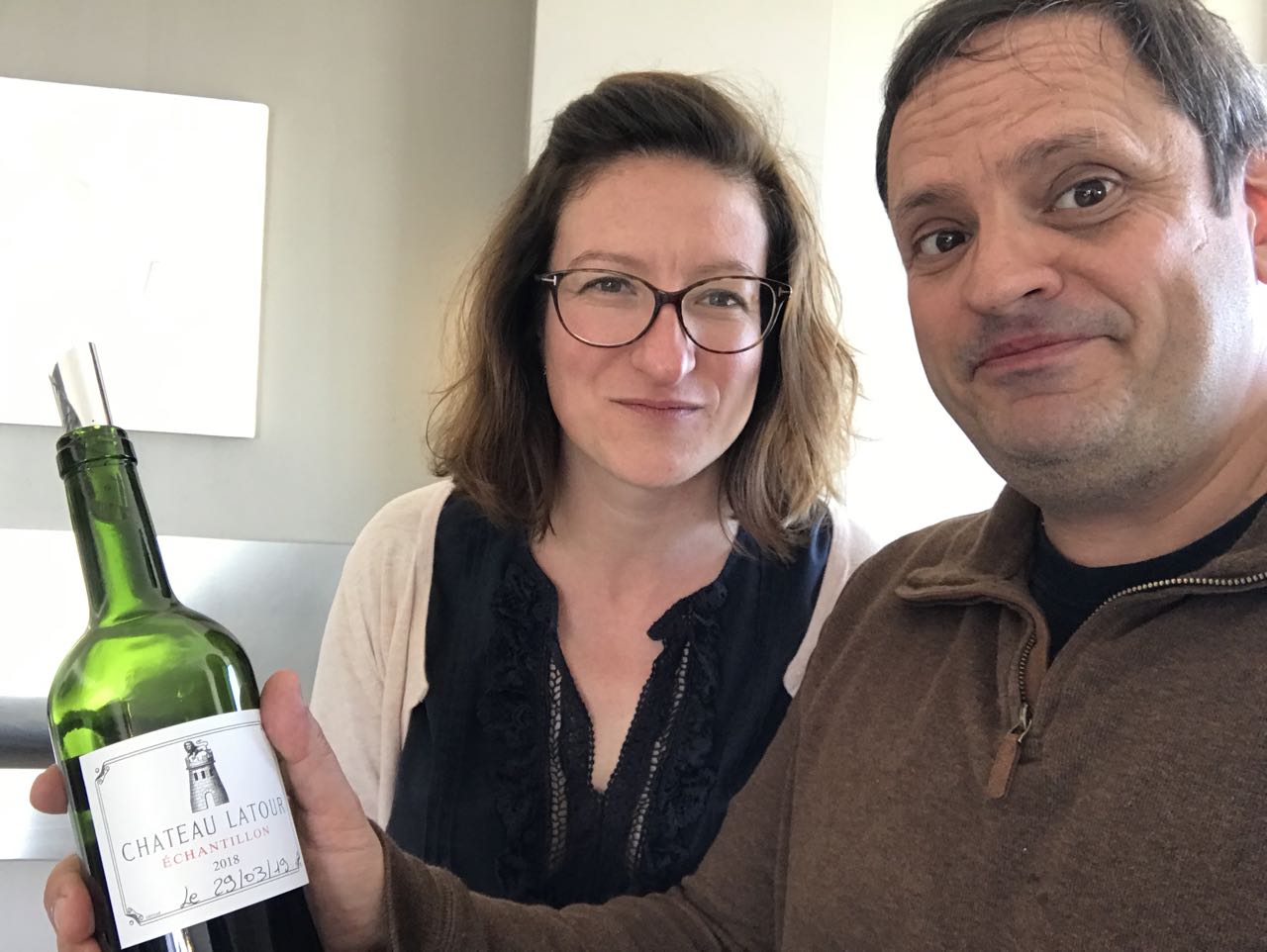
With Château Latour technical director Hélène Génin: great wine in the making!
Château Latour – At 91% Cabernet Sauvignon and the rest Merlot, the wine of this venerable first growth clocks in at 14.3% alcohol with high tannins. Indeed, the impression of tannic power is more pronounced here then almost anywhere else, so that one senses a “true Pauillac”, and a return to the style of yesteryear. Tasted with technical director Hélène Génin, who stressed that 2018 was “not an easy vintage by any measure” and that despite the constant rain earlier in the year, moderate hydric stress was observed in the vineyards. Less than 40% of the harvest was used for the grand vin, whose tannin index reaches 81. The resulting wine bears the hallmark of sweltering summer temperatures (second only to 2003, the total heat accumulated throughout the growing season reached record highs). That is to say that there were days and nights of heat, resulting in significant “evapotranspiration” as the vines were “suffering” by mid August, she said. Much work needed to pick only the best berries for the grand vin. Indeed, those selected proved to be tiny but with remarkably concentrated phenolic compounds, again necessitating careful extractions in the winemaking. The end result? The graphite and the cassis are oh so pure and there is such impressive length, along with power and a tannic edge that reminds me of vintages like 2005. A great wine in the making! (96-99)

With Mouton Rothschild director Philippe Dhalluin. Could the 2018 reach 100 points?
Château Mouton Rothschild – As at other estates this year, less pumping over and more care so as to avoid too much tannin extraction. Already, the sample we tried at the estate was two days old: on purpose, explained director Philippe Dhalluin, because the tannins are quite high (the official measure is 88 IPT, so not as high as chez Ducru Beaucaillou, but still high). The blend of 86% Cabernet Sauvignon, 12% Merlot and the rest Petit Verdot will likely age less than normal in 100% new oak, just to obviate excessive oak tannin extraction. Indeed, the “highest ever” alcohol for Cabernet that Dhalluin has seen – 13.8% – combined with high tannin does not need too much more tannin. But what about the wine? Well, it is certainly dense, with plenty of deep, dark ripe fruits of blackberry and dark cherry, with graphite and even hints of black tea. Quite an imposing style, where the density and structure overtake at this very early stage the succulence that one typically gets from this estate. This comes across to me as a modern era 1986, which is a superlative wine (100 points, according to legendary critic Robert Parker), and where this wine may be heading. But for now, my score is conservative, as we need to be sure that the barrel aging will round out the tannin even more to reach some kind of “perfection”. For now, an excellent Mouton! 96-98
Château Pedesclaux – Fruit driven, rich and ample on the palate. I like the fruit, and it is like 2009 all over again, but better, with improved structure. I can only recall, since I enjoyed the 2009 on a business class Lufthansa flight earlier this year. The sweet fruit on the nose is delectable. This is not like a “mini Latour” style Pauillac … but more easy going. I do not think it is necessarily better however than the 2016, which may end up being a longer term wine. 92-94
Château Pibran – Bargain alert! Another late ripening terroir that excelled in the vintage. The blend – at 54% Cabernet Sauvignon and the rest Merlot – has slightly more Cabernet than the average as they were “magnificent”, remarked Christian Seely. But the Merlots also were “the best we have seen here”. So, win-win. I think the wine is ripe and delicious and deep. Of course the tannins lack the refinement of Pichon Baron, or even Les Tourelles, but the wine is seductive, and it reminds me of the excellent 2009. 90-93

Château Pichon Baron – What a great wine indeed. Director Jean Rene Matignon remarked that this is “dans l’esprit d’un millésime solaire comme 2009, mais un peu plus de fraicheur”. I like this quite a lot! And, hey, I loved the 2009, so this is a good quote. This blend of 78% Cabernet Sauvignon and 22% Merlot has loads of ripe fruit and dark fruit and a contained opulence. This is power house wine, and svelte enough. The staff, as we also tasted with Christian Seely, are not too concerned about the high pH levels and the alcohol (at 14.1% is the “highest ever” for the estate, Seely said). He also feels that the 2018 “will not close down, over time” which has been more or less the case with the 2009. I sense just a bit of ether, if vaguely on the finish, but I am probably quibbling. For aging, “we could use 100% new oak, but we will stay at 80 to 90%”, Seely added. There is power, but velvety tannins at work here that balance is nicely struck, and you get some superb pencil lead aspects. Harvest began on 24 September with Merlot through to 11 October for the Cabernet. Sadly, mildew reduced overall yield, so down less than 10 per cent on yields, with overall yield at 37 hectoliters per hectare. 95-97
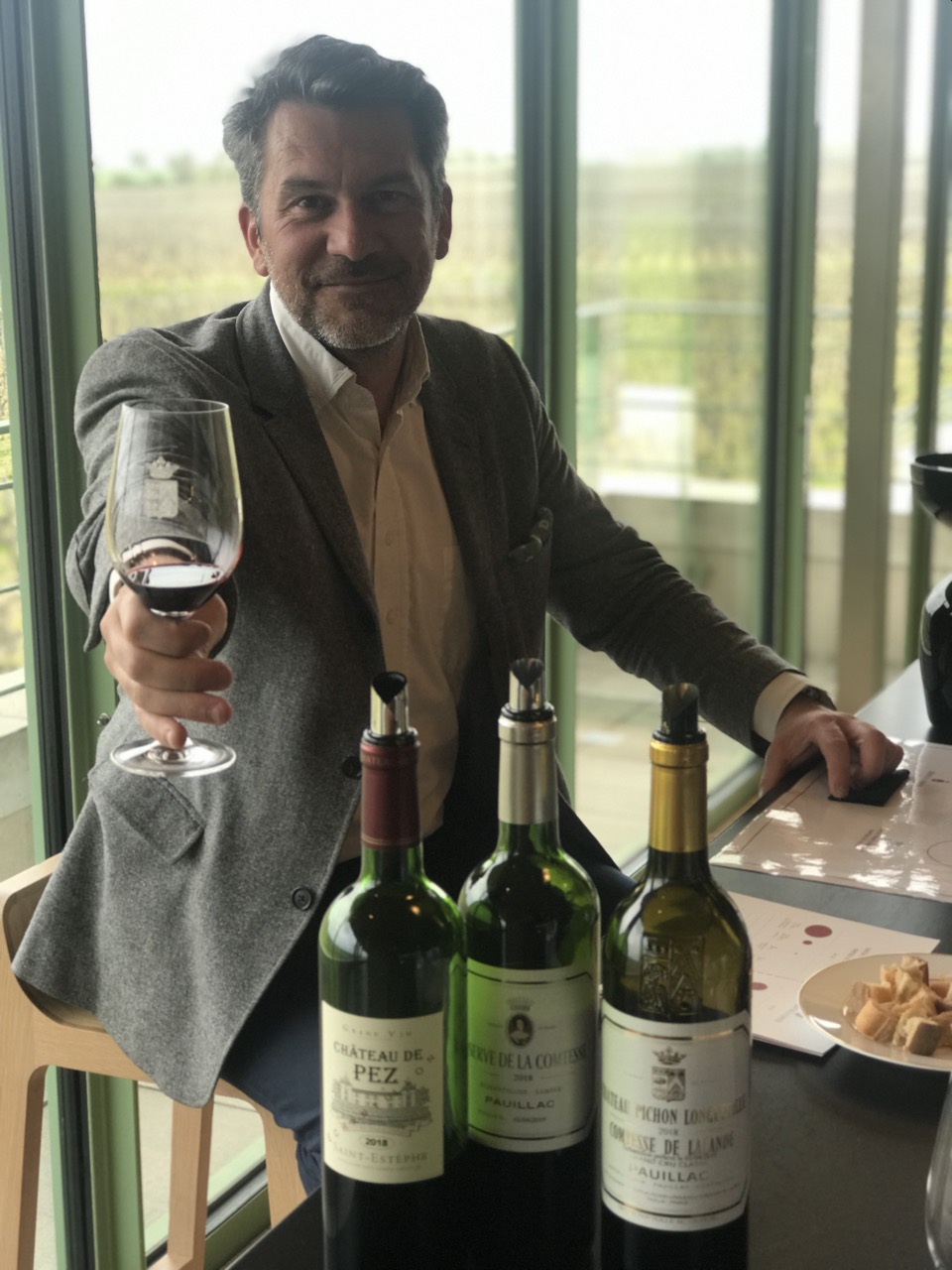
Cheers to a Super Second worthy of a First: Nicolas Glumineau of Château Pichon Longueville Comtesse de Lalande
Château Pichon Comtesse de Lalande – Super Second, anyone? In terms of higher end price-quality ratios, this is your ticket. Here we have a tour de force that rivals both Latour and Margaux. Such a smooth Pichon Comtesse, once again proving the cliché that it comes across just as much Saint Julien as Pauillac. It stands out before all other Pauillac wines assessed last week at the UGCB tasting. At once supple and elegant, yet layered and long. What a great performance! Tasted twice again, at the negociant Joanne on 31 March and at the château three days later: sheer elegance, with iodine freshness. Alcohol is 14% precisely with just enough balancing acidity and plenty of tannin. “Many things made me think of 2010,” says director Nicolas Glumineau, as we have not seen such quality of must since the 2010 (when he was at Montrose). Powerful but fresh. Here a case where the 2018 enters legend and may well surpasses the 2016. Oh, and special mention to the second wine, Reserve de la Comtesse, well worth purchasing in 2018! 96-98
Château Pontet Canet – Very pure and pristine in expression, this vintage. Sadly very low yields as the mildew eliminated much of the potential harvest here: the estate is 100% organic and thus – like Château Palmer – suffered more than most because of the mildew. But what has been made represents one of the very best wines at the estate. The wine is more about finesse than density, approaching a Lafite like elegance. Bravo! 95-97
Reserve de la Comtesse – This second wine of the great Pichon Comtesse de Lalande exudes freshness and elegance. Indeed, much of the blend comes from vines planted in 2011, which will be used in later years for the first wine. Alcohol is set at 14% precisely, with high tannin and enough acidity for balance. Bravo! 92-94
Les Tourelles de Longueville – The 66% Merlot here, with 20% Cabernet Sauvignon and the rest Cabernet Franc and Petit Verdot, really shines in 2018, exhibiting freshness and elegance. A lovely Tourelles! There is indeed “gravity” to the Merlots, but also freshness. Aging just 12 months in 30% new oak, the tannin is à point here, and the aging will refine the wine even more. I would seek this out for its ripe red fruit aspects and notions of wet stone seriousness. Excellent! 91-94
 Wine Chronicles
Wine Chronicles
Share This